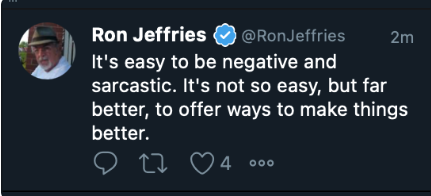According to several recent articles, somewhere in the neighborhood of 75%-94% of all agile transformations will fail. It's a startling statistic, and one I couldn't find a solid reference. It seems most people believe it to be true, but really hasn't been any studies to back up this claim. For the purposes of this article, I'm going to assume its fairly accurate - as it matches my experience and anecdotal evidence over the past 15 years. And yet, the business of agile transformation is booming. Demand for frameworks, training, and coaching/consulting services is rising. As of this writing, on LinkedIn alone, there are over 24,000 job openings for agile coach in the United States. Companies are clearly hiring for help in the pursuit to be more agile in the way they work.
So why do so many agile transformations fail?
Some of the main reasons would be:
1. You are trying to follow a framework
2. You have the wrong people.
3. You see a transformation as a light switch
You are trying to follow a framework
So many organizations seem to think that if they just follow a set of instructions, they will be an agile organization. This is especially true of large scaling frameworks - they look good ( and sell even better) but I'm not sure they actually deliver true results. This doesn't mean that frameworks are bad, it just means they aren't the solution. Frameworks are good places to start, but they shouldn't be considered a plug -and-play solution. You can follow a framework perfectly and still be one of the least agile organizations. Agility in organizations is about mindset, of the employees and the leadership - not about compliance with a framework. Start with a framework if you must, then adapt it to fit your business goals and needs.
You have the wrong people
Since agility in organizations is ultimately about mindset of people, it could be that you have the wrong people in your organization. None of us likes to consider this factor, but I've seen it time and time again - where a person that believes everything must be planned in advance is put in a position to work in an agile area. Leaders must consider mindset fit when making this type of transition, offer training and mentoring to help the individuals, but ultimately may need to make a decision to either move those people off that agile project or help them find a new role somewhere else.
You see a transformation as a light switch
Many years ago, an agile training and consulting company I was working with went on a sales call with a major US retailer. In the discovery call with the potential client, our team was laying out a transition strategy, an alignment of organizational goals for this transition, and a way to discover what might be the best fit for them as an organization. Thats when the most Senior VP in the room said " I don't really want this rollout plan, I just want you to flip it ". This leader saw a shift to agility for their extremely large organization as simple as turning on a light switch.
Organizational change is hard, and takes time. If consultants were brutally honest with you ( like we were with this potential client) moving a traditionally structured organization through an agile transformation can take years, or even decades depending upon the size of the company. And since organizations are always losing staff and hiring staff, the process likely will never be " done". Transformations are never finished. Even after 4 years at my last company, we had made excellent progress, but will always have a ways to go.
Wrapping up
Leaders should understand that starting a transformation will take serious time and investment, and still may not be successful. Invest in the individuals in your organization constantly and consistently, and don't look for some framework to be the destination. This is a worthy journey, that can produce an organization that is far more responsive to the ever changing world of business.
Patience, focusing on the real goals of why you are making this shift, and ensuring you have the right mindset can hep you be far more successful.







